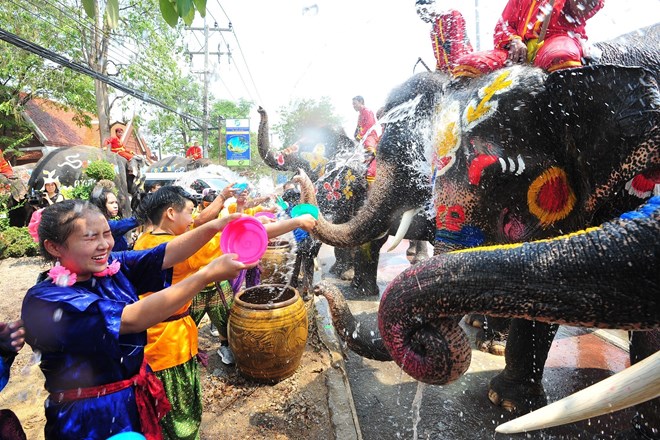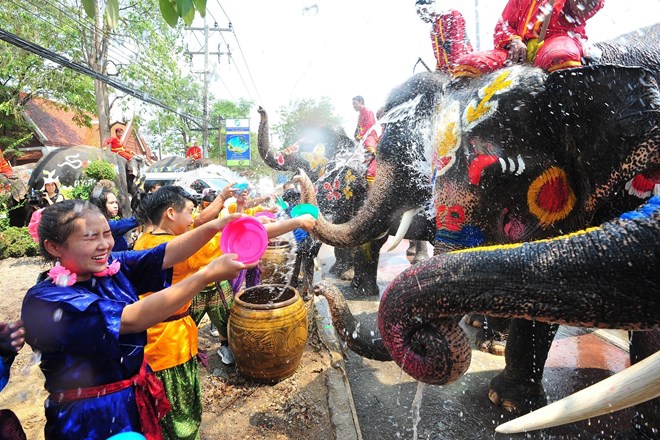
People in Thailand are joyfully celebrating Songkran – the traditional New Year festival of the country.

Thai people celebrate the Songkran festival in Ayutthaya city on
April 11 (Photo: Xinhua/VNA)
According to traditional customs, in the morning of April 13 – the official
date of Songkran, Thai people visit pagodas to offer incense to and bathe the
Buddha so as to show their respect for the Buddha and pray for good luck in the
New Year.
After that, people take to the streets to welcome the New Year by dressing
colourfully, dancing and splashing water on one another. The Thai believe that
the wetter people are, the luckier they will be.
Since 2018, the Thai Government has extended the Songkran festival to five
days, from April 12 to 16, so that people can have more time to return to their
hometowns.
In Bangkok, a number of activities will take place on Wisutkasat Road under
the Rama VIII Bridge and at Siam Square from April 13 to 15 like parades,
shows of traditional costumes, ceremonies of bathing the Buddha by four ASEAN
countries, arts performances, and water games.
In this year’s Songkran message, Prime Minister Prayut Chan-o-cha called on
Thai people to promote solidarity to maintain peace and steer the country
towards democracy. He said Thai people should work together to reduce conflict
and learn to forgive and put their problems behind them during the Songkran
festival.
Thailand, with about 94 percent of its population being Buddhist followers, and
some other Southeast Asian countries like Laos, Cambodia and Myanmar have the
tradition of celebrating the Buddhist New Year.
The name Songkran comes from a Sanskrit word meaning "passing” or
"approaching”. The festival is also related to the agricultural cycle in
Southeast Asia.
Source: VNA
The 45th General Assembly of the ASEAN Inter-Parliamentary Assembly (AIPA-45) opened in Vientiane on October 19.
Many countries are grappling with rapidly aging population. As population aging becomes an irreversible global trend with significant impacts on economic and social sectors, nations face the urgent task of creating flexible policies to adapt to and make the most of this trend to build prosperous and sustainable societies.
With a series of stimulus measures, the world tourism industry is on the way to recovery as before the COVID-19 pandemic broke out. Facing the opportunity to take off, the "smokeless industry” is expected to strongly contribute to global economic growth while promoting potential and cohesion, contributing to peace and sustainable development.
The danger from the COVID-19 pandemic is still latent, threatening people’s health and lives in the context that the immunity provided from the COVID-19 vaccine has decreased. Many other dangerous diseases are also likely to break out when the global vaccination rate slows down, due to inequality in access to health services, vaccine hesitancy, and consequences of economic recession.
The Association of Southeast Asian Nations (ASEAN) is witnessing a rise in the sales of electric vehicles (EVs) in Vietnam, Malaysia and Indonesia, according to Maybank Investment Bank Research (Maybank IB Research).
The respect paying ceremony for Party General Secretary Nguyen Phu Trong continued on the morning of July 26 at the National Funeral Hall in Hanoi, with high-level delegations from foreign countries and international organisations paying their last respects and expressing deep condolences.



